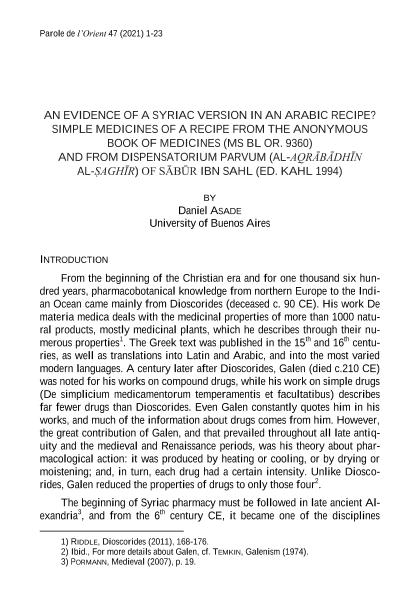Artículo
An Evidence of a Syriac Version in an Arabic Recipe? Simple Medicines of a Recipe from the Anonymous Book of Medicines (MS BL OR. 9360) and from Dispensatorium Parvm
Fecha de publicación:
12/2023
Editorial:
Université Saint-Esprit de Kaslik
Revista:
Parole de l'Orient
ISSN:
0258-8331
Idioma:
Inglés
Tipo de recurso:
Artículo publicado
Clasificación temática:
Resumen
From the beginning of the Christian era and for one thousand six hundred years, pharmacobotanical knowledge from northern Europe to the Indian Ocean came mainly from Dioscorides (deceased c. 90 CE). His work De materia medica deals with the medicinal properties of more than 1000 natural products, mostly medicinal plants, which he describes through their numerous properties1 . The Greek text was published in the 15th and 16th centuries, as well as translations into Latin and Arabic, and into the most varied modern languages. A century later after Dioscorides, Galen (died c.210 CE) was noted for his works on compound drugs, while his work on simple drugs (De simplicium medicamentorum temperamentis et facultatibus) describes far fewer drugs than Dioscorides. Even Galen constantly quotes him in his works, and much of the information about drugs comes from him. However, the great contribution of Galen, and that prevailed throughout all late antiquity and the medieval and Renaissance periods, was his theory about pharmacological action: it was produced by heating or cooling, or by drying or moistening; and, in turn, each drug had a certain intensity. Unlike Dioscorides, Galen reduced the properties of drugs to only those four2 .
Palabras clave:
Syriac
,
Arabic Recipe
,
Dioscorides
,
Simple medicines
Archivos asociados
Licencia
Identificadores
Colecciones
Articulos(CCT - PATAGONIA CONFLUENCIA)
Articulos de CTRO.CIENTIFICO TECNOL.CONICET - PATAGONIA CONFLUENCIA
Articulos de CTRO.CIENTIFICO TECNOL.CONICET - PATAGONIA CONFLUENCIA
Citación
Asade, Daniel Julio; Druille, Paola Ivone; An Evidence of a Syriac Version in an Arabic Recipe? Simple Medicines of a Recipe from the Anonymous Book of Medicines (MS BL OR. 9360) and from Dispensatorium Parvm; Université Saint-Esprit de Kaslik; Parole de l'Orient; 49; 12-2023; 1-23
Compartir




